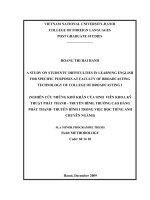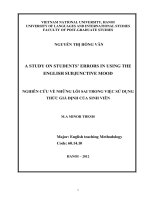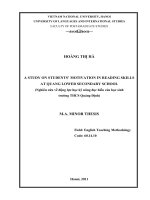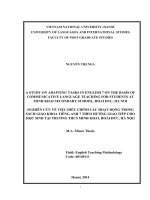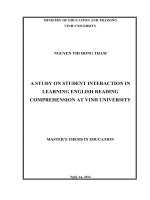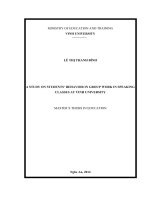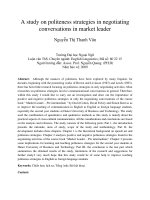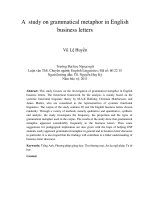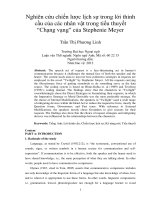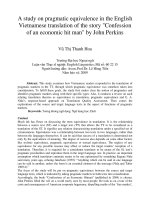A study on students'''' behavior in group work in speaking classes at Vinh Uiniversity
Bạn đang xem bản rút gọn của tài liệu. Xem và tải ngay bản đầy đủ của tài liệu tại đây (3.04 MB, 83 trang )
MINISTRY OF EDUCATION AND TRAINING
VINH UNIVERSITY
LÊ THỊ THANH BÌNH
A STUDY ON STUDENTS’ BEHAVIOR IN GROUP WORK IN SPEAKING
CLASSES AT VINH UNIVERSITY
MASTER’S THESIS IN EDUCATION
Nghe An, 2014
MINISTRY OF EDUCATION AND TRAINING
VINH UNIVERSITY
LÊ THỊ THANH BÌNH
A STUDY ON STUDENTS’ BEHAVIOR IN GROUP WORK IN SPEAKING
CLASSES AT VINH UNIVERSITY
Major: Teaching English to Speakers of Other Languages (TESOL)
Code: 60140111
MASTER’S THESIS IN EDUCATION
SUPERVISOR: Lê Phạm Hoài Hương, Assoc. Prof., Ph.D.
Nghe An, 2014
ACKNOWLEDGEMENTS
First of all, I would like to express my very affectionate and deeply-felt thanks
to my supervisor, Assoc. Prof. Dr. Le Pham Hoai Huong, for giving effective
instructions and invaluable advice during the preparation and completion of this
graduation paper. I owe her a dept of gratitude that cannot be measured.
I also wish to acknowledge my debt to all the teachers of the Foreign
Languages Department at Vinh University as well as some teachers from Vietnam
National University, Hanoi – College of Foreign Languages, whose lectures and
ideas have inspired my thesis and whom it is impossible to thank individually.
My appreciation also goes to the students at Vinh University for their valuable
assistance in completing my survey questionnaire and providing me with a lot of
useful information.
Finally, I would like to send my great thanks to my family, my friends who
have directly or indirectly helped me with their encouragement and advice.
On the whole, without all these help my graduation paper would not have
possibly been completed.
Due to limited scope, it is sure that in this graduation paper, mistakes are
inevitable, that is why I hope to receive further comments and advice to make it
better.
Vinh, 2014.
LE THI THANH BINH
i
ABSTRACT
This study was set out to investigate students’ behavior in group work in
speaking classes at Vinh University. The study used both quantitative and
qualitative approaches in methodology. A questionnaire was sent to 100 students
who came from different regions from mountainous areas to city centers and had no
common in major. Interview data was also collected with 10 students and 5
teachers. These teachers have had a period of time applying group work in English
speaking classes. In addition, observation was conducted in some classes with
group work activities.
Results highlight the complexity of what happens when students work in
groups in English speaking classes. Some dominant behavior of students in group
work includes impatience, selfishness, impoliteness, embarrassment and non-
cooperation with partners. The study also shows that there is a conflict between
teachers’ intentions and students’ interests. They seem dissatisfied with some of
teachers’ decision, especially comments and marks. Therefore, teachers’ roles in
those classes are strongly emphasized although students are still center of the class.
Based on the findings of the study, implications were made for teachers and
students in managing group work.
ii
TABLES AND CHARTS
iii
LIST OF ABBREVIATIONS
CLT: Communicative Language Teaching
CLL: Cooperative Language Learning
EFL: English as a Foreign Language
ESL: English as a Second Language
GW: Group Work
iv
TABLE OF CONTENTS
v
CHAPTER 1 INTRODUCTION
1.1. Rationale
Nowadays, people seem to familiar with terms “global citizen”, “interaction”,
“collaboration” which highly consider the relationship between person and person.
Therefore, the word “group work” has gradually become a key term in any fields of
life such as business, sport and education. It can be seen that group work enhance
effective and efficient achievement of an organization’s work; members of a team
are more committed to work on goals that they help to create. Moreover, everyone
in group work can contribute their unique abilities and they have a sense of
belonging (Davis, 1993). Problem-solving, persuasive argumentation and teamwork
are necessary skills and valued by employers.
Group work is also emphasized in Communicative Language Teaching which
is popular in teaching methodology in many countries. Barkley (2005) believes that
learners will obtain several benefits. Group work is one pedagogical strategy that
promotes participation and interaction. It fosters a deeper and more active learning
process, and it also provides instructors with valuable demonstrations of the degree
to which students understand particular topics or concepts. In addition to exposing
students to different approaches and ways of thinking, working with other students
in groups can promote a sense of belonging that combats the anonymity and
isolation that many students experience at a large campus. Some students may
initially be reluctant to participate in group work, so sharing the reasons for group
work with your students can help to convince the reluctant ones. It might help them
to know that research has shown that groups frequently devise more and better
solutions than the most advanced individual . Working together in groups also gives
students the opportunity to learn from and teach each other. Classroom research has
shown that students often learn better from each other than they do from a teacher .
However, the complexity of what occurs when students are placed in groups
as part of their English speaking lessons should be explored. It is difficult to find
1
out what the students actually behave in these situations. It is clear that students in
groups often do not do what the teacher expects. Neither do the students always
move towards the teacher’s intentions when working in groups. Breen (1987: 23)
warns that ‘learners are capable of playing havoc with the most carefully designed
and much-used task’.
Being a teacher at Vinh University, the author has recognized that group work
is widely used in any English speaking classes but students’ behavior is various.
And she wants to do research on it with the hope to find out positive and negative
sides of group work and contribute some suggestions to build better speaking
classes.
Those reasons above lead to the study “A study on students’ behavior in
group work in English speaking classes at Vinh University”.
1.2 Research aims:
- To understand how group work is carried out in English speaking classes at
Vinh university.
- To find out how students behave with each other and with teachers during
the time working in groups.
- To recommend practical suggestions to boost good behavior in group work
and decrease short- comings.
1.3 Research questions:
The research tries to answer the following questions:
1. What do students think of group work carried out in English speaking
classes at Vinh university?
2. How do students behave in group work in English speaking classes at this
university?
3. What should be changed to improve the effectiveness of group work in
English speaking classes?
2
1.4 Research significance
The research zooms in the way students behave and react with each other and
with teachers. That helps teachers know what students like to do and what they do
not. The research focuses on understanding students’ needs, thoughts and ideas in
group work. From that teachers can modify group work effectively in order that
students feel excited to join in any activities with others.
1.5 Scope of the study
Many sides of group work have been studied by researchers. They have
described its advantages and disadvantages, methods to manage group work. They
have also found out activities related to group work in reading, writing, listening
and writing. In this thesis, the author would like to pay attention on students’
behavior in group work in English speaking class.
The research collects statistics from survey with 100 students, interview 10
students and observations of some classes at Vinh University.
1.6 Thesis structure
The study consists of five chapters:
Chapter 1, entitled “Introduction”, outlines the background of the study. In this
part, the author presents the reasons for choosing the topic, the purposes, the scope,
the research questions, and the organization of the study.
Chapter 2 , ‘Literature Review’, presents an overview of what is group work,
its advantages and disadvantages; definition of behavior; previous studies related to
this topic in foreign countries and in Vietnam.
In Chapter 3, “Methodology” presents the detailed procedure of the study: the
methodology, population selection, data collection and analysis.
Chapter 4 is the “Findings and Discussion” which provides data description
and analysis with findings.
The last chapter, “Conclusion and Recommendations”, summarizes main
points and contents of the study based on the results of the study; suggests some
techniques for teaching and presents the recommendation for further research.
3
CHAPTER 2 LITERATURE REVIEW
2.1 Introduction
This chapter presents the literature review. First, it will present the definitions
of key terms such as “group work”, “speaking”, “behavior”. Then, it introduces the
roles of group work in speaking classes and its relationship with students’ behavior.
Readers can find out some previous studies of this topic in foreign countries and
Vietnam. Especially, it explains the reason why there should be the current study.
2.2 Definitions of key terms
2.2.1.Group work
While there are some very different ways of defining groups – often
depending upon which aspect of them that commentators and researchers want to
focus upon – it is worthwhile looking to a definition that takes things back to basics.
Forsyth (2006: 2-3) defines a group as “two or more individuals who are connected
to one another by social relationships”. This definition has the merit of bringing
together three elements: the number of individuals involved, connection, and
relationship.
Doff (1988: 137) also defines group work as a process that “the teacher
divides the class into small groups to work together”. (Usually four or five students
in each group, as in pair work, all the groups work at the same time).
Like pair work, group work also gives students more opportunities to practice
the target language in the whole class. In addition, students can work independently
and freely under the teacher’s control without the pressure of the whole class
watching what they are doing.
2.2.2.Speaking
Speaking is the productive skill in the oral mode. It is crucial to human
communication. Different linguistics have different concepts of speaking: Brown
(1994) defines speaking as a process of constructing meaning that involves
producing, receiving and processing information. Brown and Yule (1983) also
pointed out that spoken language consists of short, fragmentary utterances in a
4
range of pronunciation, adding that spoken language is made by using the loosely
organized syntax, and non-specific words, phrases and filters such as oh, well, uhuh
etc. Speaking requires learners to use grammar, vocabulary or pronunciation to
produce speech and understand when, where, why and in what ways to produce
language.
It is obvious that speaking is the key to human communication. Though
speaking takes many definitions, following are some of the definitions by the most
famous researchers According to Byrne (1976:8), “Speaking is a two-way process
between the speaker(s) and the listener(s) involving the productive skill of speaking
and the receptive skill of understanding.” Both the listener and the speaker have a
positive function to perform: the speaker has to encode the message to be conveyed
in appropriate language, while the listener has to decode the message. The message
itself in normal speech usually contains a great deal of information that the listener
needs. And at the same time, the listener is helped by the speakers’ prosodic
features such as stress and intonation which accompany the spoken utterances and
form part of its meaning, and also by his facial and body movements.
Brown (1983) also reveals that speaking is an interactive process of
constructing meaning that involves producing, receiving and processing
information. Its form and meaning are dependent on the context in which it occurs,
including the participants themselves, their collective experiences, the physical
environment, and the purposes for speaking. It is often spontaneous, open ended
and evolving. However, speech is not always unpredictable. Language functions
that tent to recur in certain discourse situations (declining and invitation, requesting
time off from work) can be identified and charted. Speaking requires not only that
learners know how to produce specific points of language, such as grammar,
pronunciation, vocabulary (linguistic competence), but also that they understand
when, why and in what way to produce language (sociolinguistic competence).
Scott (1978) mentions that an activity involving two or more people in which
the participants are both hearers and speakers having to react to what they hear and
5
make their contribution is speaking. Each has an intention or a set of intentions that
he wants to achieve in the interaction and an ability to interpret what is said to him
which he can not predict exactly either in terms of form or in terms of meaning.
Chaney (1988:13) defined “Speaking is the process of building and sharing
meaning through the use verbal and non-verbal symbols in a variety of contexts”.
In general, different researchers have different concepts of speaking but they
all agree with one very important feature of speaking, that is a two way process
between the speaker and listener.
2.2.3. Behaviour
According to wikipedia “Behavior or behaviour is the range of actions and
mannerisms made by organisms, systems or artificial entities in conjunction with
themselves or their environment, which includes the other systems or organisms
around as well as the (inanimate) physical environment. It is the response of the
system or organism to various stimuli or inputs, whether internal or external,
conscious or subconscious, overt or covert, and voluntary or involuntary”. Basing
on this definition, students’ behaviors in groupwork are all actions and mannerisms
which students behave with their partners, with group members and with teacher.
Under the circumstance of English language speaking class, they are various. Some
may be easily recognized but some probably need more time to analyze. Some of
them can be either positive or negative for the purpose of cooperating to study
English language speaking
Durand (1990) outlines four possible functions of behavior: to escape, to
obtain a tangible thing, to engage in sensory activities, and to get attention. These
functions describe the benefit students get from the behavior - a benefit they may
not even be aware of - and help us understand how to intervene to help students
change the behavior.
Escape-motivated behavior occurs when a student attempts to avoid a task,
demand, situation, or person. This can be easy to recognize - for example, when
students run out of the classroom during reading. Sometimes it's less obvious - for
6
instance, when kids argue to get out of doing an activity that makes them anxious.
Common school procedures, such as time-outs or sending the student to the
principal's office, can reinforce escape-motivated behavior because they remove the
student from the undesirable activity - just what the student wanted.
We can understand tangible behavior in two ways: when the function of the
behavior is to obtain a tangible object like money or food or, when the function is to
attain a specific agenda. The student wants what he wants; when he wants it.
Students who are self-centered and have inflexible thinking often fall into this
category. Some children with a history of abuse or neglect may have a low
frustration tolerance and operate with the assumption that the only way to get their
needs met is to grab the thing they want or overpower someone.
We see sensory behavior when a student is motivated by sensory input:
Things feel good, look good, taste good, or sound good. Humming loudly while
writing, chewing on the end of a pencil, or standing rather than sitting while
working are all typical behaviors that fall into this category. These become
problems when they interfere with learning, are disruptive, or make students look
odd to their peers.
Finally, with attention-motivated behavior, the student tries to gain attention
from an adult or peer. This can present as the student being belligerent, screaming,
or continually interrupting the teacher. It can also work in the positive—that is, the
girl who dresses up so a boy will notice her or a child who works hard on his
reading so the teacher will praise him.
Led by Rachel Scherr (2009), members of the Physics Education Research
group at the University of Maryland have tried to systematize their observations of
student behavior during tutorials. Student activities during tutorials can be divided
into four different behavioral clusters of activities. Because each cluster of activities
has different kinds of meaning, the researchers have chosen to describe the clusters
in terms of colors.
7
When a group of students are in the blue behavioral cluster, they are either not
speaking or speaking quietly in low subdued tones with little or no gestures used.
Their eyes are directed towards their worksheet and typically their bodies are
hunched over the desk. Speech is not necessarily directed at others. Students are
said to be in a “worksheet” frame for this particular behavioral cluster.
Students are in the green behavioral cluster when they are actively talking to
one another about the tutorial content. Students tend to gesture more frequently in
this cluster, sit up straight, and make eye contact with one another as they talk.
Scherr and her colleagues indicate that the students are framing the tutorial as a
“discussion.”
In the red behavioral cluster, students are interacting with the teaching
assistant or instructor for the course. Eye contact is typically made with the teaching
assistant or instructor and voices and gestures are more subdued in this frame. They
are in the “receptive to TA” frame.
When students in a group are laughing, fiddling about, and goofing off, they
are in the yellow behavioral cluster. Students are typically laughing and fiddling
around during this frame. They are more likely to be touching their faces or hair and
are not talking about tutorial content. Such behavior indicates that they frame that
moment as an opportunity of socializing.
Most teachers, in many different learning cultures, have moments when their
students fail to cooperate in some way, thus disrupting the learning which should be
taking place, sometimes getting significantly “out of control”. Such moment of
disruption can be unsettling not just for teachers but also for students.
Problem behavior can take many forms; Paul Waddon and Sean McGovern
(1991) list disruptive talking, inaudible responses, cheating in test and unwilling to
speak in the target language. Of course, their list may reflect the education culture
where they were teaching rather than being universal. In other contexts we may add
behaviours such as insolence to the teachers, insulting or bullying other students,
damaging school property and refusing to accept sanctions or punishment.
8
However, what is characterized as discipline depends on what counts as a well-
ordered or disciplined classroom for the individual teacher (Brown and McIntyre
1993:44).
2.3.Group work
2.3.1.Advantages
Research on cooperative learning establishes that working collaborates with
others can increase achievement (Slavin, 1990). Group-work provides students
opportunities to learn by helping each other. From a theoretical perspective, both
the help- giver and the help- receiver stand to benefit from sharing information.
Group work has been incorporated into language teaching and learning in most
parts of the world since the emergence of the Communicative Language Teaching
(CLT) in the early 1970s, and has taken firm root in many present-day ESL or EFL
classrooms. This approach came into being because of the ever-growing need for
the use of language for communicative purposes, and because of the fact that a lot
of educators and linguists became more and more dissatisfied with the Audio-
Lingual and Grammar-Translation methods of language teaching. In this context,
there began a movement away from traditional lesson formats where emphasis was
put on the mastery of different items of grammar, hence shifting practice from
controlled activities such as mechanical memorization of dialogs and drills towards
communicative activities, which can be successfully done through group work.
According to Brumfit (1984), group work is often considered an essential feature of
communicative language teaching. In favor of it, Long & Porter (1985) hold that
GW can promote students’ practice, the quality of their talk, their motivation, and
positive classroom atmosphere. Salmon (1988) supports Long & Porter’s ideas and
adds that group work also helps increase students’ confidence.
Similar to CLT, Cooperative Language Learning (CLL) also promotes
learning through communication in pairs or small groups. CLL is an approach to
teaching that makes maximum use of cooperative activities involving pairs and
small groups of learners in the classroom. This means each learner is held
9
accountable for his or her own learning and is motivated to increase the learning of
others (Olsen & Kagan, 1992, p.8). The concept “cooperative” in CLL emphasizes
an important aspect: developing classrooms that foster cooperation rather than
competition in learning. That is to say, students in pairs or groups work together
towards a common goal instead of competing with one another for individual
ambitions.
Other benefits which group work may offer are mentioned below. First of all,
it may maximize each learner’s opportunity to speak and that practicing in pairs and
groups will reduce to some extent the psychological burden of public performance.
Thanks to group work, students will also have more language practice opportunities
and the time they will have for interacting with one another in pairs and groups is
absolutely abundant. Second, pair and small group activities enable students to take
a more active role in their learning as well as to act as an important resource person
for one another (McGroarty, 1989). Last, students learn best when they are actively
involved in the learning process via pairs or groups. According to Davis (1993),
students working in small groups tend to learn more of what is taught and retain it
longer than when the same content is presented in other instructional formats.
2.3.2 Disadvantages
Besides the aforesaid advantages, several possible problems and difficulties
may arise in a class using group work. Because a lot of groups work at the same
time, the first problem language teachers might confront is that the class gets rather
noisy and out of hand. We think it is natural for a teacher to feel a need to keep
control of the class, but we need to differentiate between ‘productive’ and
‘unproductive’ noises. The former is exactly what most teachers want to achieve,
not the latter. A classroom full of students in pairs or groups talking and interacting
in English, even if it is really noisy, is surely what we wish. A high level of noise
during this session can be tolerated since this is a good sign signifying that the
students feel engaged, included and enthusiastic about learning itself when
communicating with their friends. Long & Richards (1987) maintain that a learner-
10
centered class like the above, where learners do most of the talking in pairs or
groups, and take responsibilities for using communicative resources to complete a
task, proves to be more conducive to language learning than a teacher-centered
class. Consequently, the noise which seems to be an inevitable problem in any
classrooms can sometimes be very beneficial.
Difficulty in monitoring the class is also a problem for teachers. As Kumar
(1992) mentions, large class size might make interaction and involvement difficult.
It is obvious that in Vietnam’s language teaching context, a classroom often houses
approximately over 40 students. That is to say, a teacher has to monitor at the same
time lots of pairs and groups. As a result, he or she will not be able to equally give
help and advice to every pair or group.
When conducting group work techniques, teachers may encounter some
problems as follows:
Harmer (1999: 125) points out that “Some pairs may find it impossible to
concentrate on the task in hand and instead encourage each other to talk about
something else, usually in their first language. In some groups, members may defer
to the oldest person there, or to the man in otherwise female group. People with
loud voice can dominate proceedings, less extrovert people may not participate fully
enough”.
He also states some following problems teachers deal with when applying
group work in their teaching. Firstly, group work is frequently noisy, so teachers
may lose control of their class. Secondly, some students would prefer to the focus of
the teacher’s attention rather than working with their peers. Thirdly, individuals
may fall into group roles that become fossilized, so that some are passive whereas
others may dominate. Finally, students in pairs or groups may not focus on the point
of their task, but talk about something else, often in their mother tongue.
Obviously, it is difficult for teachers to control all groups at once. Some
students don’t like working groups. Also, they sometimes use their mother tongue
instead of the target language when working in groups.
11
In addition, Ngoh (1991) discovers that some students may choose to remain
silent or may not listen to the others because of cultural differences or lack of co-
operation among the students in pairs or in groups. He also adds “students who are
linguistically deficient tend to resort to their mother tongue when they are engaged
in group work interaction”. Another problem given by Ngoh (1991) is “the
administration of small group work is a demanding and arduous process, as it is a
careful planning, preparation and constant motoring”.
Besides, teachers fear that the potential chaos and conflicts may arise within
groups and that in classrooms where students share a common native language, they
have the tendency to overuse the mother tongue. With the former problem, teachers
ought to effectively manage the conflicts that are inevitable in groups. Cognitive
conflict among students, if managed effectively, can be very constructive, leading to
increased motivation and to higher levels of cognitive development and moral
reasoning, as Johnson & Johnson (1979) propose. With the latter problem, because
students feel more secure with their own language, they tend to turn to mother
tongue whenever they engage in a conversation or a discussion, and this can be
tolerated only for the first time.
To sum up, teachers have to deal with a number of problems while conducting
group work . However, those problems may be overcome if “ teachers consider
various factors at different stages of pair work and group work from planning,
practice, instruction, organization and process stage to the presentation stage” (Sim
Grek Ngoh, 1991). Also, group work can be conducted successfully if an
appropriate task is selected.
2.3.3.The formation of group work
We have to decide how to put individual students into pairs and groups. There
are a number of factors we might consider when doing this. According to Harmer
(1999), we can base such a decision on any of the following principles:
12
Friendship
A key consideration when putting students in pairs or groups is to make sure
that we put friends with friends rather than risking the possibility of people working
with others whom they find difficult or unpleasant. However, our observation may
not always accurate and friendship can change from time to time.
We can also ask students to get into pairs or groups with whom they like. But
letting students choose their partner(s) in this way may exclude less popular
students.
In addition, a sociogram can be used to group students. In this way, students
are asked to write their name, the students they like best in the class on a piece of
paper and the students they don’t like on the other side. The teacher can use this
information to make sociograms. However, sociograms are time consuming and
also fail to answer the problem of what to do with unpopular students.
Streaming: Students can be streamed according to their ability.
The first suggestion is that pairs and groups should have a mixture of weaker
and stronger students. Therefore, the more able students can help their less able
students.
The second one is that we can create groups in which all the student are at the
same level. This may give us the opportunity to go to a group of weaker students
and give them special help they need. However, some of the values of cooperative
work may be lost.
Besides, we can stream students on the basis of participation. Students less
participating in the lesson may be put together in a group. However, the teacher
should observe and support them in order to make them concentrate more on the
lesson.
Chance: Students can be put in pairs and groups by chance. This is the easiest
way since it demands little pre-planning. We can have students sitting next to or
near each other work in pairs or groups. Also, students can be put in pairs or groups
13
at random based on the order of their birthday, or some similar features such as
wearing glasses, wearing black, or green, having the same occupation, etc.
Changing groups: The group may change while an activity continues.
Students can first work in pairs then in groups of four, then groups of eight, or even
sixteen.
Additionally, teachers can group students based on some following criteria
given by Honeyfield (1991).
Free- grouping: students make their own decision about who to work with.
Same proficiency level grouping: students of the same proficiency level are
grouped together.
Mixed proficiency level grouping: students are grouped so that each group
has a mix of proficiency levels.
Random grouping: students are located to group in some random way on the
basic of who is sitting next to whom in the class.
Grouping based on other differences: in a mixed class, students are grouped
so that each group has a mix of some other characteristics, e.g. sex, age, nationality,
mother tongue or ethnic origin.
In short, our grouping decision is made based on a variety of factors. We can
put students in pairs or in groups differently according to our own purpose or the
class’s atmosphere or characteristic.
2.3.3.4 Procedures for pair work and group work
Harmer (1999) suggests three stages in carrying out pair work and group work
as follows:
Before: we need to give instructions to let students understand what they are
going to do, give them ideas of when they will have finished the task they are going
to get involved in. Sometimes, we may ask them to repeat the instructions or to
translate them into their first language so as to check that they do understand. In
some cases, our instructions may involve a demonstration.
14
During: while students are working in pairs or groups we have a number of
options. We could, for instance, stand at the front or the side of the class or
anywhere else in the classroom, and keep an eye on what is happening. Therefore,
we can “tune in” to a particular pair or group from some distance away. We then
decide whether to go over or to help that pair or group.
Instead, we can also go round the class watching and listening to specific pairs
and groups. Then we may stop and intervene if it is appropriate or necessary. We
can give them support and suggestions but it is vital that we bear in mind the most
appropriate way to do so.
According to Sun Grek Ngoh (1991), group work can be organized in a lesson
as stages below
PLACE STAGE EXPLANATION
Before
entering the
classroom
Planning stage The teacher maps out the specific objectives she
intends to achieve, and the tasks to realize the
objectives set.
In the
classroom
Practice stage
Instruction stage
Organization stage
Process stage
Presentation stage
Post small group
work stage
The teacher equips the students with the
necessary structures or vocabulary to achieve the
tasks set.
The teacher gives clear, detailed instructions for
the required tasks.
The teacher arranges the students into groups,
making sure there is control and order.
The students are engaged in oral interaction in
groups in order to achieve the task assigned.
The group leaders present the product so that the
other students can hear or read.
The teacher assigns a related task to reinforce
learning, and self- evaluates what has been done,
and makes amendments to future group work.
Table 2.1: Stages in implementing group work (Ngoh, 1991)
15
After: when pairs and groups stop working together we need to organize
feedback. We may have a few pairs or groups quickly demonstrate the language
they have been using. We can then correct it, if and when necessary and this
procedure will give both those students and the rest of the class good information
for future learning and action. Constructive feedback can greatly enhance students’
future motivation.
2.4.Speaking
2.4.1.Characteristics of speaking
Spoken and written language make different demands on language producers
(Brown, 1983). Unlike readers or writers, speakers may need patience and
imagination. They take turns by turn in a conversation. After a speech, the speaker
should let a gap of time for the listener to say. Communication rarely works when
two or more people are speaking at the same time. To have an integral and equal
relationship, each person needs to feel that others are listening to their problems and
speech, and they need to be able to do the same for others.
The following are characteristics of speaking:
The context in which it occurs creates its form and meaning, “including the
participants themselves, their collective experiences, the physical environment, and
the purposes for speaking” (Maryann, 1999). It is often unlimited, open-ended, and
evolving. Nevertheless, speech may be predictable. Language roles that tend to
repeat in some discourse contexts can be recognized and painted.
Speaking offers that participants know how to use and give out certain points
of language called “linguistic competence” such as vocabulary, grammar,
intonation, as well as that they understand when, why, and in what ways to produce
language “sociolinguistic competence”.
Bygate (1987) confirms speaking as an undervalued skill in many ways. As
the fact that almost all people can speak, and so take speaking skill too much for
granted. He also asserts that speaking skill deserves attention every bit as much as
literacy skilled. Learners often need to be able to speak with confidence in order to
16
carry out many of their most basic transactions. Bygate also highly appreciates
speaking by stating that speaking is the medium through which much language is
learnt.
In conclusion, it is reasonable that speaking is a way to communicate with
people. By studying what a speaker should do, what activities should be used in a
speaking class, and what students’ needs and suggestions, teachers can help learners
enhance their speaking skill and oral competence.
2.4.2 Problems with speaking and speaking activities
2.4.2.1. Problems with speaking
Brown (1994) studies characteristics of spoken language and finds out the
problems of speaking. He points out as follows:
- Clusterings: In order to speak fluently, speakers have to select from their
store of language clustering that is groups of words, not word by word.
- Reduced forms: Contractions, elisions, reduced vowels, etc. create difficulties
in teaching and learning spoken English. If learners do not learn colloquial
contractions, they can develop the kind of speaking that is stilted and bookish.
- Colloquial language: Colloquialism appears both in monologues and
dialogues. If learners are only exposed to standard English and/or “textbook”
language, they sometimes find it hard to understand and produce words, idioms and
phrases of colloquial language.
- Stress, rhyme and intonation: Learners of English often find it difficult to
pronounce English words, to stress the right syllables, to follow the stress-times
rhythm and intonation patterns of spoken English.
- Affective factors: Learners learning to speak often encounter the risk of
saying out things that may be wrong, stupid and incomprehensible. At those times,
they tend to be anxious because they do not want to be judged by other learners.
- Interaction: The greatest difficulty that learners face in learning to speak
originates from the interactive natural of most communication. Engaging in process
of negotiation of meaning with many discourse constraints, learners have to do the
17
complex task of choosing what to say, how to say, when to speak, etc. Learners are
affected by their interlocutors’ performance.
2.4.2.2.Problems with speaking activities
Speaking activities seem exciting, attractive and easy to design. Nevertheless,
there are problems teachers often meet when carrying out. Ur (1996:121) lists out
the following:
- Worries: Unlike reading, writing or listening activities speaking requires
some degree of real-time exposure to an audience. The student speaker has to face
the teacher and other students in class. Learners are often worried about trying to
says something in a foreign language in the classroom because they are worried
about making mistakes, afraid of criticism or losing face, or simply shy of the
attention that their speech attracts.
- Nothing to say: Teachers often hear learners; even if they are not worried or
nervous, complain that they can not have anything to say. They may have no
motivation to express themselves beyond the guilty feeling that they should speak.
When they say something in class, they feel that they are forced to say.
- Uneven or low participation: Usually, there are many students in one class
(between 25 and 35 students). Only one student can talk at a time in a large group.
This means that each one have only very little time for talking. This problem is
compounded by the tendency of some learners to dominate the group, while others
speak very little or not at all. In some cases some students haven’t got any chance,
intentionally and unintentionally, to speak for a long time.
- Mother-tongue use: When all, or a number of the learners share the same
mother tongue, they may tend to use it frequently. This happens because the native
language is easier to use and because they feel unnatural to speak to one another in
a foreign language and become learners feel less “exposed” if they are speaking the
language they master. If they are talking in a small group, it can be quite difficult to
get some classes, particularly the less disciplined or motivated ones, to keep to the
target language.
18
